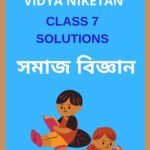SEBA Class 7 Social Science MCQ Chapter 14 The Sources of the Historical Study of Medieval Indian Solutions in English Medium, Class 7 Social Science Multiple Choice Question Answer in English to each chapter is provided in the list so that you can easily browse throughout different chapters SEBA Class 7 Social Science MCQ Chapter 14 The Sources of the Historical Study of Medieval Indian and select need one.
SEBA Class 7 Social Science MCQ Chapter 14 The Sources of the Historical Study of Medieval Indian
Also, you can read the SCERT book online in these sections Class 7 Social Science Objective Type Solutions by Expert Teachers as per SCERT (CBSE) Book guidelines. These solutions are part of SCERT All Subject Solutions. Here we have given Assam SEBA Class 7 Social Science Multiple Choice Questions and Answer for All Subject, You can practice these here.
The Sources of the Historical Study of Medieval Indian
Chapter – 14
HISTORY
| MCQ |
1. What is the importance of sources in the study of history?
(A) They provide entertainment.
(B) They help in constructing historical narratives.
(C) They are used for decoration.
(D) They are irrelevant.
Answer: (B) They help in constructing historical narratives.
2. Which of the following is considered a primary source of Medieval Indian history?
(A) Novels.
(B) Ancient inscriptions.
(C) Modern newspapers.
(D) Comic books.
Answer: (B) Ancient inscriptions.
3. Who wrote the ‘Rajatarangini,’ an important historical source of Medieval India?
(A) Kalhana.
(B) Banabhatta.
(C) Kalidasa.
(D) Fa-Hien.
Answer: (A) Kalhana.
4. Which foreign traveler’s account provides information about the Vijayanagara Empire?
(A) Marco Polo.
(B) Ibn Battuta.
(C) Nicolo Conti.
(D) Hiuen Tsang.
Answer: (C) Nicolo Conti.
5. What is the significance of the writings of Al-Biruni in the context of Medieval Indian history?
(A) They provide insights into ancient Roman history.
(B) They offer a detailed account of Indian society and culture during his time.
(C) They describe the geography of Europe.
(D) They are purely fictional.
Answer: (B) They offer a detailed account of Indian society and culture during his time.
6. Which medieval Indian text is a significant source for studying the Chola administration?
(A) Arthashastra.
(B) Brihadeswara Temple inscriptions.
(C) Manusmriti.
(D) Rajatarangini.
Answer: (B) Brihadeswara Temple inscriptions.
7. Who among the following was a Venetian traveler who visited India during the Medieval period?
(A) Al-Biruni.
(B) Ibn Battuta.
(C) Nicolo Conti.
(D) Marco Polo.
Answer: (D) Marco Polo.
8. Which source provides detailed information about the Delhi Sultanate?
(A) Ain-i-Akbari.
(B) Tarikh-i-Firuz Shahi.
(C) Rajatarangini.
(D) Arthashastra.
Answer: (B) Tarikh-i-Firuz Shahi.
9. Which famous Persian traveler visited India during the reign of Muhammad bin Tughluq?
(A) Ibn Battuta.
(B) Al-Biruni.
(C) Marco Polo.
(D) Hiuen Tsang.
Answer: (A) Ibn Battuta.
10. What type of sources include monuments, artifacts, and inscriptions?
(A) Literary sources.
(B) Archaeological sources.
(C) Oral sources.
(D) Digital sources.
Answer: (B) Archaeological sources.
11. The ‘Ain-i-Akbari’ is an important source for understanding the administration of which Mughal emperor?
(A) Babur.
(B) Humayun.
(C) Akbar.
(D) Aurangzeb.
Answer: (C) Akbar.
12. Who authored the ‘Ain-i-Akbari’?
(A) Ibn Battuta.
(B) Abul Fazl.
(C) Al-Biruni.
(D) Amir Khusrau.
Answer: (B) Abul Fazl.
13. Which famous traveler from Morocco visited India during the 14th century?
(A) Marco Polo.
(B) Ibn Battuta.
(C) Hiuen Tsang.
(D) Fa-Hien.
Answer: (B) Ibn Battuta.
14. The inscriptions of which king provide detailed information about the Rashtrakuta dynasty?
(A) Ashoka.
(B) Krishna I.
(C) Harsha.
(D) Rajendra Chola.
Answer: (B) Krishna I.
15. Which medieval historian wrote the ‘Prithviraj Raso’?
(A) Kalhana.
(B) Chand Bardai.
(C) Amir Khusrau.
(D) Al-Biruni.
Answer: (B) Chand Bardai.

Hi! my Name is Parimal Roy. I have completed my Bachelor’s degree in Philosophy (B.A.) from Silapathar General College. Currently, I am working as an HR Manager at Dev Library. It is a website that provides study materials for students from Class 3 to 12, including SCERT and NCERT notes. It also offers resources for BA, B.Com, B.Sc, and Computer Science, along with postgraduate notes. Besides study materials, the website has novels, eBooks, health and finance articles, biographies, quotes, and more.




